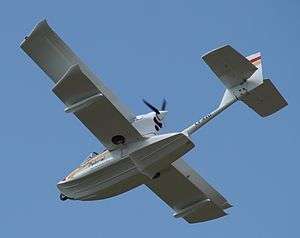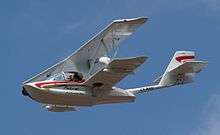EDRA Aeronautica Super Pétrel
The EDRA Aeronautica Super Pétrel is an amphibious pusher configuration biplane, seating two side-by-side, brought into production in Brazil in 2002 though with a French parentage. It remained in production in 2011, in kit and flyaway forms.[1][2]
| Super Pétrel | |
|---|---|
 | |
| Lithuanian-registered Super Pétrel | |
| Role | Two-seat amphibious biplane |
| National origin | Brazil |
| Manufacturer | EDRA Pecas e Manutencao Ltda Scoda Aeronáutica |
| Introduction | 2002 |
| Status | in production |
| Number built | 214 by December 2009; further 160 kits by end 2007. |
| Unit cost |
2018 prices for Super Pétrel in US$: 189,000 |
| Developed from | EDRA Aeronautica Paturi |
Design and development
The design of the Super Pétrel has its origins in Claude Tisserand's Hydroplum, a single-seat, wooden amphibian intended for kit building first flown in 1983 and its two-seat, Rotax 532-powered development, the 1986 Hydroplum II. The Société Morbihannaise d'Aéro Navigation (SMAN) acquired production rights to the latter in 1987, marketing it as the Pétrel, and passed them on to Billie Marine when SMAN ceased trading. Rights were also bought outside France; EDRA began Pétrel production in Brazil in 1989. In 1991 they began producing the improved Paturi, which replaced the Pétrel entirely in 1996 but was itself replaced by the Super Pétrel in 2001.[3][4]
By 2014 the design was being produced by Scoda Aeronáutica of Ipeúna, São Paulo, Brazil.[5]
The Super Pétrel is of mixed construction, though with much use of composite materials. The wings have tubular aluminium alloy spars combined with PVC foam ribs. The leading edges and wingtips are formed from glass fibre composite, with fabric covering elsewhere. The wings have constant chord and zero sweep, with angled winglet tips; the upper wing has the greater span, less dihedral (2° 13′ compared with 3° 26′). There is slight stagger. The Super Pétrel is a single bay biplane with N-form aluminium interplane struts with an additional diagonal strut in each bay from the lower fuselage to the top of the interplane struts. The centre section is supported by a pylon or cabane which also contains the engine mounting. Ailerons are carried only by the upper wings; there are no flaps. The wings can be disassembled in about 30 minutes for transportation by trailer.[3]
The single-step hull is an epoxy/carbon fibre foam monocoque, with a carbon fibre boom supporting the all-composite, cruciform and wire braced tail unit. The rear control surfaces are balanced. The cockpit is forward of the central pylon and seats two side-by-side with dual controls. It may be flown open, with just a windscreen, or enclosed by the single piece, forward-hinged canopy. There is a baggage compartment behind the seating. The Super Pétrel has a short legged tricycle undercarriage for land operation; the main units, which have hydraulic brakes, retract upwards through 90° into the sides of the hull with the wheels exposed but recessed into the underside of the lower wing. The steerable nosewheel retracts forward, leaving the tyre partly exposed as a docking fender. A pair of small, stepped floats on the lower wings below the interplane struts stabilise the aircraft on water.[3]
The Super Pétrel is powered by a 73.5 kW (98.6 hp) Rotax 912ULS flat-four engine mounted in pusher configuration on the central pylon just below the upper wing. It drives a three-blade Airplast propeller, either a fixed pitch model 175 or an electrically controlled, variable pitch model PV 50.[3]
Operational history
Seven Super Pétrels appeared on the civil aircraft registers of European countries, excluding Russia in mid-2010.[6] There have also been sales in North America, Africa, Australia and New Zealand[3] as well as in Brazil where there were 50 registered by December 2009.[7]
Variants

- Super Pétrel
- Superseded Paturi after 2002. Lowered engine line, revised undercarriage and controls. Structural alterations with more carbon fibre; wingtips with washout and winglets which increased the span of both wings; floats moved from tips to wing underside.
- Super Pétrel LS
- 280 mm (11 in) longer and with a 25 km/h (16 mph) increase in cruising speed; greater fuel capacity; redesigned cabin and tail group.
- AAC SeaStar SP
- North American version marketed by Amphibian Airplanes of Canada (AAC).
Specifications (Super Pétrel LS)
Data from Jane's All the World's Aircraft 2010/11[3]
General characteristics
- Capacity: two
- Length: 6.25 m (20 ft 6 in)
- Upper wingspan: 8.90 m (29 ft 2 in)
- Height: 2.33 m (7 ft 8 in)
- Wing area: 15.00 m2 (161.5 sq ft)
- Airfoil: NACA 2412
- Empty weight: 320 kg (705 lb)
- Max takeoff weight: 600 kg (1,323 lb)
- Fuel capacity: 90 L (23.8 US gal; 19.8 Imp gal)
- Powerplant: 1 × Rotax 912 ULS flat four, air- and water-cooled, 73.5 kW (98.6 hp)
- Propellers: 3-bladed Airplast 175, 1.65 m (5 ft 5 in) diameter
Performance
- Maximum speed: 190 km/h (120 mph, 100 kn)
- Cruise speed: 180 km/h (110 mph, 97 kn) maximum
- Stall speed: 56 km/h (35 mph, 30 kn)
- Never exceed speed: 210 km/h (130 mph, 110 kn)
- Range: 950 km (590 mi, 510 nmi) with maximum fuel
- Service ceiling: 3,050 m (10,010 ft) service
- g limits: +4/-2
- Rate of climb: 5.08 m/s (1,000 ft/min) maximum at sea level
- Wing loading: 40.0 kg/m2 (8.2 lb/sq ft) maximum
- Take-off run on land: 80 m (265 ft)
- Take-off run on water: 120 m (395 ft)
- Landing run on land: 120 m (395 ft)
- Landing run on water: 100 m (330 ft)
References
- Bayerl, Robby; Martin Berkemeier; et al: World Directory of Leisure Aviation 2011-12, page 44. WDLA UK, Lancaster UK, 2011. ISSN 1368-485X
- Tacke, Willi; Marino Boric; et al: World Directory of Light Aviation 2015-16, page 44. Flying Pages Europe SARL, 2015. ISSN 1368-485X
- Jackson, Paul (2010). Jane's All the World's Aircraft 2010-11. Coulsdon, Surrey: IHS Jane's. pp. 35–6. ISBN 978-0-7106-2916-6.
- "Paturi". Archived from the original on 6 April 2012. Retrieved 22 December 2011.
- Scoda Aeronáutica (2014). "Company". Retrieved 10 February 2017.
- Partington, Dave (2010). European registers handbook 2010. Air Britain (Historians) Ltd. ISBN 978-0-85130-425-0.
- Jackson, Paul (2011). Jane's All the World's Aircraft 2011-12. Coulsdon, Surrey: IHS Jane's. p. 31. ISBN 978-0-7106-2955-5.
External links
| Wikimedia Commons has media related to Super Petrel. |